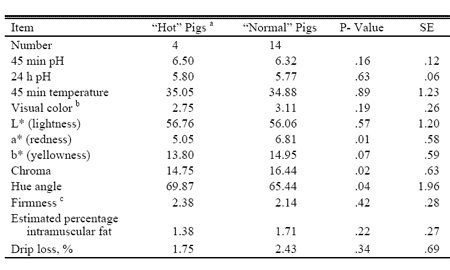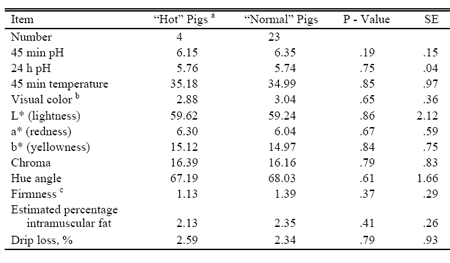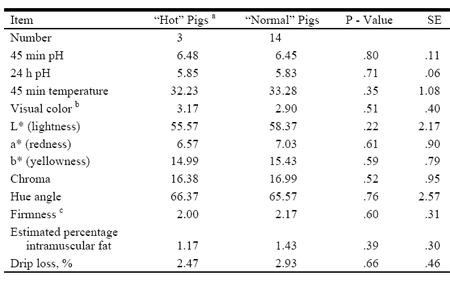Utilizing Infrared Thermography to Predict Pork Quality
Three experiments using 63 pigs were conducted to determine if infrared thermography could segregate pigs based on subsequent pork quality. Pigs were subjectively classified as either “hot” or “normal” based on infrared surface temperature of the loin region prior to slaughter. In the first experiment 18 market weight pigs were transported, imaged by infrared thermography and slaughtered immediately after 1 to 4 h of lairage.
Differences in meat quality were detected; hot pigs had lower a* (less red) and chroma (less intense red color) values, and higher hue angle (less red/more yellow) values, all of which indicate paler muscle color. In the second experiment, 27 market weight pigs were transported, held in lairage for 12 to 16 h, imaged by infrared thermography, and then slaughtered. In the third experiment, 18 market weight pigs were transported, imaged by infrared thermography, held in lairage for 12 to 16 h, and then slaughtered.
Regardless of the time infrared images were taken, no meat quality differences between hot and normal pigs were detected when pigs were held in lairage for 12 to 16 h. These data suggest that measurement of live animal surface temperature by infrared thermography may allow for detection of poor meat quality if pigs are slaughtered without extended lairage.
Introduction
Ten to 16% of the U.S. pork supply has PSE (pale, soft, and exudative) meat characteristics. Estimates of unrealized revenue due to the PSE meat condition total $275 million annually for the U.S. pork industry. Currently, methods for identifying individuals or groups of pigs likely to result in PSE meat quality are not in commercial use. If a method was utilized prior to slaughter, intervention strategies could be put in place to reduce the risk or prevalence of PSE carcasses. A proposed method is infrared thermography (IRT). Infrared thermography is a rapid, non-invasive procedure used to measure the surface temperature of an object without having any physical contact to the object. Previous scientific literature concerning the relationship between IRT and PSE meat suggest that pigs with surface temperatures warmer than normal are likely to yield carcasses with pale muscle color and higher moisture losses. The objective of this research was to determine if infrared thermography could segregate live pigs based on subsequent muscle quality.
Procedures
Surface temperatures of 63 market pigs slaughtered in three groups were collected using a short-wave infrared radiometer (PM 280 Thermacam, Inframetrics, N. Billerica, MA) prior to slaughter at the KSU Meat Laboratory. Subjective infrared temperature determination of “hot” (pigs with thermal images in the top 1.5ºC of the temperature spectrum) or “normal” was made for each the hips. In the first experiment, pigs (n=18) were transported from the KSU swine farm to the meat laboratory, scanned by infrared thermography and then slaughtered immediately after 1 to 4 h lairage. For the second experiment, pigs (n=27) were transported from the KSU swine farm to the meat laboratory, held in lairage overnight for 12 to 16 h, scanned by infrared thermography and then slaughtered. For the third experiment, pigs (n=18) were transported from the KSU swine farm to the meat laboratory, scanned by infrared thermography, held in lairage overnight for 12 to 16 h, then slaughtered. At 45 min postmortem, 10th rib longissimus muscle pH and temperature was measured with a portable meter (Accumet AP61, Fisher Scientific, Pittsburgh, PA). At 24 h postmortem after a 30 min bloom, 10th rib loin chops were evaluated for visual (NPPC) and instrumental color (L*, a*, b*; 10º observer, Illuminant C; HunterLab Miniscan, Hunter and Associates, Reston, VA), firmness (NPPC), marbling (estimated percentage of intramuscular fat; NPPC), drip loss (fishhook method), and ultimate (24 h) pH. Chroma (C*ab = {a*2 + b*2}1/2) and hue angle (hab = arctan{b*/a*} also were calculated.
For each experiment, data for this observational study were analyzed as one-way treatment structure in an unbalanced completely randomized design. Individual pigs were the experimental units.
Results and Discussion
Significant differences in a* values were detected between hot and normal pigs from experiment 1 (Table 1). Hot pigs had lower (P=0.01) a* (less red) values than normal pigs. In addition, hot pigs tended (P=0.07) to have lower b* (less yellow) values than normal pigs. Moreover, hot pigs had lower (P=0.02) chroma (less intense red color) and higher (P=0.04) hue angle (less red/more yellow) values than normal pigs. These data are consistent with previous literature in that lower a* and chroma values as well as higher hue angle indicate pale muscle color, a key trait of PSE meat. In contrast, previous literature would indicate that PSE pork should have higher b* values than normal pork. No differences between hot and normal pigs were detected for 45 min or 24 h pH, 45 min temperature, visual color scores, L* (lightness), firmness, marbling, and percentage of drip loss.
Table 1. Variation in Pork Longissimus Muscle Quality from Pigs Transported, Imaged by Infrared Thermography and then Slaughtered Immediately after 1 to 4 h of Lairage (Experiment 1)

a Pigs with infrared thermographs in the top 1.5oC of the temperature spectrum.
b 1.0 = pale pinkish gray to white, 2.0 = grayish pink, 3.0 = reddish pink, 4.0 = dark reddish pink, 5.0 = purplish red, 6.0 = dark purplish red.
c 1.0 = soft, 2.0 = firm, 3.0 = very firm.
Pigs for experiment 2 and 3 were held in lairage overnight for 12 to 16 h before slaughter. No differences in any pork quality measurements were detected when pigs were scanned after lairage (Experiment 2, Table 2) or prior to lairage (Experiment 3, Table 3). It appears that after a 12 h lairage period meat quality was improved such that differences were not detectable by infrared thermography. Normal lairage conditions in commercial pork processing systems are 2 to 4 h. A 12 to 16 h lairage is considerably longer than most commercial processors and likely caused those pigs to exhaust their stored glycogen supply antemortem, thereby improving meat quality.
Table 2. Variation in Pork Longissimus Muscle Quality from Pigs Transported, Held in Lairage for 12 to 16 h, Imaged by Infrared Thermography and then Slaughtered (Experiment 2)

a Pigs with infrared thermographs in the top 1.5oC of the temperature spectrum.
b 1.0 = pale pinkish gray to white, 2.0 = grayish pink, 3.0 = reddish pink, 4.0 = dark reddish pink, 5.0 = purplish red, 6.0 = dark purplish red.
c 1.0 = soft, 2.0 = firm, 3.0 = very firm.
Table 3. Variation in Pork Longissimus Muscle Quality from Pigs Transported, Imaged by Infrared Thermography, Held in Lairage for 12 to 16 h and then Slaughtered (Experiment 3)

a Pigs with infrared thermographs in the top 1.5oC of the temperature spectrum.
b 1.0 = pale pinkish gray to white, 2.0 = grayish pink, 3.0 = reddish pink, 4.0 = dark reddish pink, 5.0 = purplish red, 6.0 = dark purplish red.
c 1.0 = soft, 2.0 = firm, 3.0 = very firm.
Infrared thermography is a rapid, non-invasive, easy-to-use technique that may allow for the detection of poor meat quality ante-mortem. Our results suggest that infrared thermography may allow for detection of poor meat quality if animals are imaged and then slaughtered immediately without extended lairage. Our findings also suggest that infrared thermography is not useful in detecting poor meat quality if pigs are allowed to rest for 12 to 16 h before slaughter.
Once a pig or group of pigs that exceeds a surface temperature threshold has been identified, intervention strategies known to improve muscle quality can be put in action to reduce the incidence of the PSE meat condition. Those strategies may include increased lairage time, water shower or pool cooling, and fan cooling. When used successfully, this strategy should reduce the percentage of PSE carcasses; thereby increasing the value of numerous carcasses and minimizing lost revenue.
by T. E. Lawrence, M. F. Spire, M. E. Dikeman, M. C. Hunt, S. B. Hogge, and B. W. James - Kansas State University Agricultural Experiment Station and Cooperative Extension Service
This article hasn't been commented yet.


Write a comment
* = required field